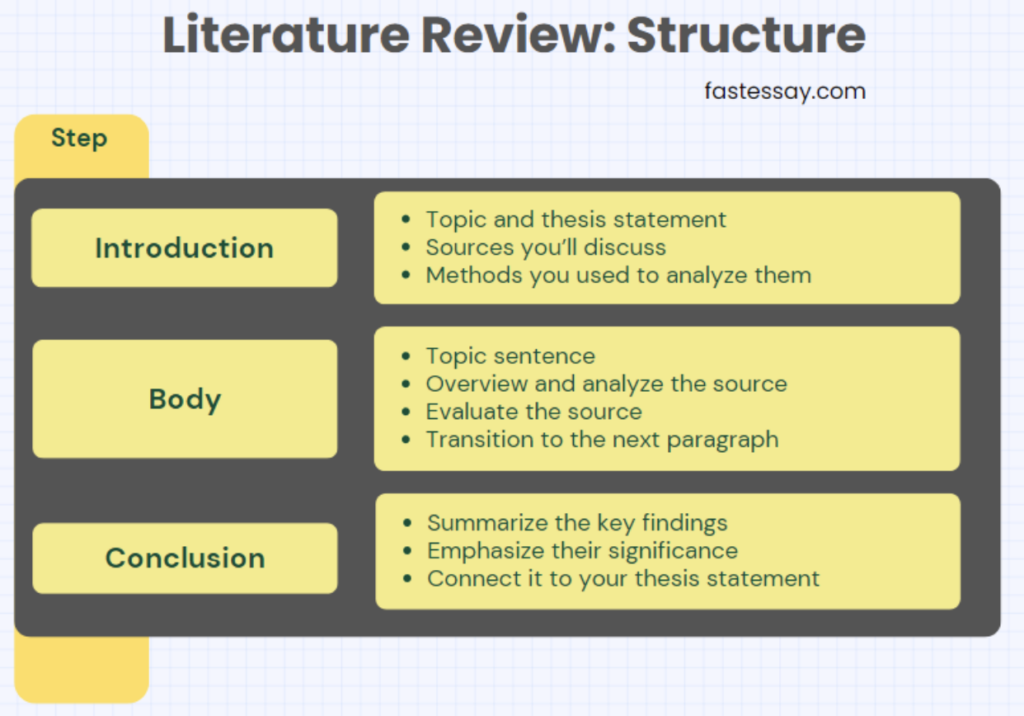In this article, you’ll learn how to write a literature review for different academic disciplines.
Look:
Literature reviews aren’t about literary works like novels or poems. When we say “literature,” we mean “the research” in a given field. Writing a literature review means collecting key sources on your topic, overviewing them, and analyzing them in relation to each other.
Here’s how you can do it fast.
What Is a Literature Review?
A literature review is an academic paper or a paper’s section overviewing the significant sources on a selected topic. Those sources may include scholarly articles, reports, edu websites, books, etc.
When writing a literature review, you need to research and collect the best sources on your topic, overview them, and describe them as a synthesis in your paper.
Please don’t confuse it with literary essays or book reviews.
As you can see from the definition, “literature” here is about research in a field; it means that you don’t review any particular literary work but rather discuss the scholarship on your topic and its relation to each other.
Two types of literature reviews
A literature review may be a separate article or a part of your more considerable work (research paper introduction, thesis, or dissertation chapter). This blog post is about writing a literature review that is a separate document.
When organizing your review’s body, you can use any of these approaches (stylistic variations to structure it):
- Chronological. Trace the development of your topic over time, but avoid simply listing the sources in chronological order. Analyze key points that shaped the direction of the field and provide your interpretations of why those developments occurred.
- Thematic. Organize your chosen sources into blocks that address different aspects of your topic and discuss each section one by one.
- Theoretical. Organize your literature by various definitions, theories, or models of your discussed concepts. Here, you may argue for the relevance of this or that theoretical approach or combine various ideas into a framework for your research.
- Methodological. This approach is about dividing the sources by the research methods their authors used (qualitative vs. quantitative methods, empirical vs. theoretical, etc.).
Whatever stylistic approach you choose, ensure that you don’t present any new research. Literature reviews are about overviewing the existing research on a specific topic.
Why write them
In school or college, educators assign literature reviews to evaluate your research skills and familiarity with the topic. The purpose is to see if you understand the scholarly context and know the scholarly debates around your subject.
You may also write literature reviews to evaluate the current state of research, develop a framework or methodology for your own research, and show how it contributes to a debate.
Literature Review Structure
As a rule, lit reviews have a basic college paper structure:
- Introductory paragraph
- Body
- Conclusion
When a review is a part of your academic work, not a separate article, make its intro and conclusion short (a few sentences), focusing on the body part instead. When writing a literature review as a standalone piece, you’ll need to craft a more precise intro section discussing your goals and research methods and place both the intro and conclusion sections separately.

Below are more details on what to include in each section of your literature review.
An introductory paragraph provides context on your topic, sources you’ll discuss, and methods you used to find and analyze them. Remember to include a thesis statement: What is your primary research question in this literature review?
When writing the body paragraphs of your literature review, include the following:
- Overview the core points of each source and combine them (summarize and synthesize).
- Analyze: Instead of paraphrasing, provide your interpretations of the research and discuss its significance for the field.
- Evaluate the discussed sources; mention their strengths and weaknesses.
- Use transition words and sentences to draw connections, contrasts, and comparisons between paragraphs.
In your literature review conclusion, summarize the key findings, emphasize their significance, and connect the conclusion to your thesis statement.
How to Write a Literature Review Step-by-Step
Now that you know a literature review’s nature, purpose, and structure, it’s time to practice.

A lot of work before writing the review involves searching, evaluating, and preparing a list of sources. Having enough time for this stage is critical if you want to write a literature review fast.
Below are your steps to writing a literature review that’s worth reading.
Step 1: Conduct research
A literature review explores what other researchers have already said concerning your thesis statement. So, it stands to reason that you need to conduct research and find existing scholarly works on your topic.
There’s a lot of existing research on a variety of fields! With more than five million new academic articles published every year, the main challenge here is to filter out the noise and find the most relevant ones for your work.
How to do that?
Start with Google Scholar, which is the Google for the academic world. List keywords related to your topic and search for them and their variables to see what this database offers. Consider the most relevant and recent results for your research question.
Other databases to try are JSTOR, Science Direct, and EBSCO. You can also check Project Muse for humanities and social sciences, Inspec for STEM, and Medline for life sciences and biomedicine. Also, remember your college or university’s library catalog.
To make the process faster, read the documents’ abstracts to analyze their relevance and check their bibliographies to get ideas on other potential sources.
AI tools also help you save time on research. Use them to find a list of scholarly works on your topic, but ensure you double-check the claims they make.
Step 2: Decide on the sources
With so many sources available, evaluating them and deciding which ones will be most relevant to include in your literature review is critical. So, your next step is cataloging:
Make detailed notes on each resource of your interest to access this data later and ensure you choose the best options for your review. It may seem an unnecessary step, but don’t avoid it. With over 100 items in your initial list, you’ll need help remembering who said what when you reach the writing phase.
A source catalog in a spreadsheet will help you analyze all the data and decide on the most relevant documents to include in your literature review.
For each publication, add the following information to the catalog:
- A question its author addresses
- Key concepts, theories, and methods
- Research frameworks (established or innovative)
- Results of that study, strengths and weaknesses
- Its relevance to other literature in the field
This step will help you digest and synthesize all the information and make connections between all the articles in your mind.
Step 3: Organize and outline your review
Depending on the approach you’ve chosen for organizing your literature review’s body paragraphs (above-mentioned chronological, theoretical, etc.), select the most appropriate sources from your catalog and write an outline for your future work.
Plan what you’ll include in every chapter.
You don’t need to be super detailed at this stage; just come up with bullet points for every paragraph so you remember all critical information and keep the connection between described concepts and frameworks when writing.
Step 4: Write the draft
Start writing your literature review. Please note that you aren’t obligated to stick to the initial outline you prepared. Think of it as a road map, but feel free to add or change some sections if necessary.
Be sure to include these three ingredients when writing:
- Theoretical framework
- Empirical research
- Research gap
These ingredients can be a basic three-part structure for your literature review, but there are also other ways. Remember your chosen approach — chronological, thematic, theoretical, or methodological — and structure your review accordingly.
Here are some practical tips for you to write a literature review faster:
- Approach your writing as an iterative process. Don’t be afraid of getting a messy first draft: You’ll have a chance to polish it over multiple rounds of editing later. So, don’t waste your time trying to write a perfect sentence or paragraph in one go.
- Focus on critical (aka analytical) rather than descriptive writing. While descriptive writing is about the “What?” concept, critical writing digs into the “So what?” approach, i.e., the implications of the fact, event, etc.
- Get your referencing right. Provide a credible, correctly formatted reference for any statement you make (unless it’s common knowledge).
- Ensure that you stick to the citation style guidelines your educator prescribed (APA, MLA, Chicago, or any other).
Step 5: Review and polish your literature reviewThe final and most essential step of writing a literature review is revising and editing the draft. Once your review is ready, check it several times to eliminate all factual, grammatical, and stylistic errors. Also, ensure that the review’s structure is clear, logical, and cohesive.
These tips will help you do it faster:
- Check the topic sentences of each paragraph: Ensure they indicate the core points of your literature review.
- Make sure you have included all the critical information you planned.
- Check all the citations and references: Do you credit them according to the required citation style?
- Ensure that you didn’t plagiarize any research idea, fact, or pattern.
- Stick to a concise academic style while writing; use formal language and focus more on analytical, not descriptive writing.
- Proofread your draft to ensure there are no typos or grammatical errors.
- Read the draft out loud: It will help you “hear” whether sentences flow smoothly and identify tiny errors you might miss during the first round of editing.
More details: 10 Simple Rules for Writing a Literature Review
Takeaways
So, here is a quick recap on writing a literature review:
- Source and catalog relevant scholarly research on your topic.
- Develop an outline; remember to synthesize, analyze, and critically evaluate sources in your review.
- Write a review and polish it over several rounds of editing.
You can use this short guide to craft solid literature reviews fast and get higher grades. Or, feel free to contact our experts from literature review writing service and ask them to assist you so you’ll spend less time writing.








